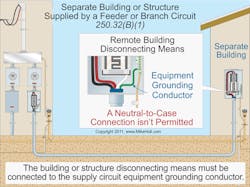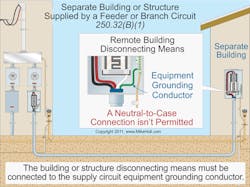Q. If I have a feeder to a remote building and I run the conductors in PVC, what are the grounding and bonding requirements for this particular installation?
A. Each building/structure's disconnect must be connected to an electrode of a type identified in 250.52 [250.32(A)]. A grounding electrode isn't required where the building/structure is served with a 2-wire, 3-wire, or 4-wire multiwire branch circuit [250.32(A) Ex].The grounding electrode conductor must terminate to the grounding terminal of the disconnecting means, and it must be sized in accordance with 250.66, based on the conductor area of the ungrounded feeder conductor [250.32(E)].
Notes:
• The grounding of the building/structure disconnecting means to the earth is intended to help in limiting induced voltages on the metal parts from nearby lightning strikes [250.4(A)(1)].
• The Code prohibits the use of the earth to serve as an effective ground-fault current path [250.4(A)(5) and 250.4(B)(4)].
• If the grounding electrode conductor is connected to a ground rod, the portion of the conductor that’s the sole connection to the ground rod isn’t required to be larger than 6 AWG copper [250.66(A)]. If the grounding electrode conductor is connected to a concrete-encased electrode, the portion of the conductor that’s the sole connection to the concrete-encased electrode isn’t required to be larger than 4 AWG copper [250.66(B)].
In regard to the bonding portion of your question, to quickly clear a ground fault and remove dangerous voltage from metal parts, the building/structure disconnecting means must be connected to the circuit equipment grounding conductor, which must be one of the types described in 250.118. If the supply circuit equipment grounding conductor is of the wire type, it must be sized in accordance with 250.122, based on the rating of the overcurrent device [250.32(B)] (see Figure).
Caution: To prevent dangerous objectionable neutral current from flowing onto metal parts [250.6(A)], the supply circuit neutral conductor isn't permitted to be connected to the remote building/structure disconnecting means [250.142(B)].
About the Author

Mike Holt
Mike Holt is the owner of Mike Holt Enterprises (www.MikeHolt.com), one of the largest electrical publishers in the United States. He earned a master's degree in the Business Administration Program (MBA) from the University of Miami. He earned his reputation as a National Electrical Code (NEC) expert by working his way up through the electrical trade. Formally a construction editor for two different trade publications, Mike started his career as an apprentice electrician and eventually became a master electrician, an electrical inspector, a contractor, and an educator. Mike has taught more than 1,000 classes on 30 different electrical-related subjects — ranging from alarm installations to exam preparation and voltage drop calculations. He continues to produce seminars, videos, books, and online training for the trade as well as contribute monthly Code content to EC&M magazine.

